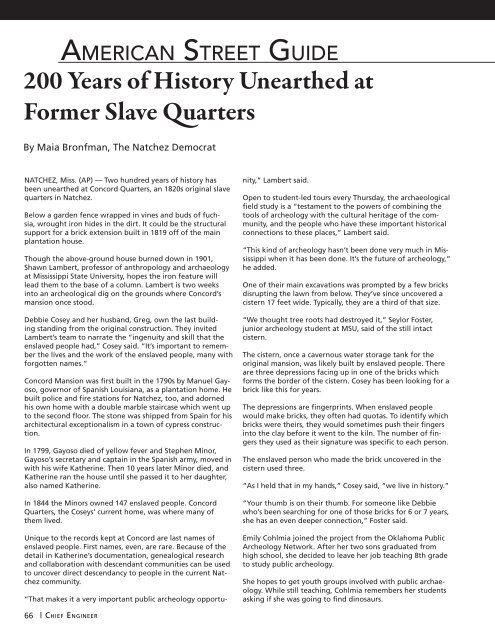CEAC-2022-08-August
You also want an ePaper? Increase the reach of your titles
YUMPU automatically turns print PDFs into web optimized ePapers that Google loves.
American Street Guide<br />
200 Years of History Unearthed at<br />
Former Slave Quarters<br />
By Maia Bronfman, The Natchez Democrat<br />
NATCHEZ, Miss. (AP) — Two hundred years of history has<br />
been unearthed at Concord Quarters, an 1820s original slave<br />
quarters in Natchez.<br />
Below a garden fence wrapped in vines and buds of fuchsia,<br />
wrought iron hides in the dirt. It could be the structural<br />
support for a brick extension built in 1819 off of the main<br />
plantation house.<br />
Though the above-ground house burned down in 1901,<br />
Shawn Lambert, professor of anthropology and archaeology<br />
at Mississippi State University, hopes the iron feature will<br />
lead them to the base of a column. Lambert is two weeks<br />
into an archeological dig on the grounds where Concord’s<br />
mansion once stood.<br />
Debbie Cosey and her husband, Greg, own the last building<br />
standing from the original construction. They invited<br />
Lambert’s team to narrate the “ingenuity and skill that the<br />
enslaved people had,” Cosey said. “It’s important to remember<br />
the lives and the work of the enslaved people, many with<br />
forgotten names.”<br />
Concord Mansion was first built in the 1790s by Manuel Gayoso,<br />
governor of Spanish Louisiana, as a plantation home. He<br />
built police and fire stations for Natchez, too, and adorned<br />
his own home with a double marble staircase which went up<br />
to the second floor. The stone was shipped from Spain for his<br />
architectural exceptionalism in a town of cypress construction.<br />
In 1799, Gayoso died of yellow fever and Stephen Minor,<br />
Gayoso’s secretary and captain in the Spanish army, moved in<br />
with his wife Katherine. Then 10 years later Minor died, and<br />
Katherine ran the house until she passed it to her daughter,<br />
also named Katherine.<br />
In 1844 the Minors owned 147 enslaved people. Concord<br />
Quarters, the Coseys’ current home, was where many of<br />
them lived.<br />
Unique to the records kept at Concord are last names of<br />
enslaved people. First names, even, are rare. Because of the<br />
detail in Katherine’s documentation, genealogical research<br />
and collaboration with descendant communities can be used<br />
to uncover direct descendancy to people in the current Natchez<br />
community.<br />
“That makes it a very important public archeology opportunity,”<br />
Lambert said.<br />
Open to student-led tours every Thursday, the archaeological<br />
field study is a “testament to the powers of combining the<br />
tools of archeology with the cultural heritage of the community,<br />
and the people who have these important historical<br />
connections to these places,” Lambert said.<br />
“This kind of archeology hasn’t been done very much in Mississippi<br />
when it has been done. It’s the future of archeology,”<br />
he added.<br />
One of their main excavations was prompted by a few bricks<br />
disrupting the lawn from below. They’ve since uncovered a<br />
cistern 17 feet wide. Typically, they are a third of that size.<br />
“We thought tree roots had destroyed it,” Seylor Foster,<br />
junior archeology student at MSU, said of the still intact<br />
cistern.<br />
The cistern, once a cavernous water storage tank for the<br />
original mansion, was likely built by enslaved people. There<br />
are three depressions facing up in one of the bricks which<br />
forms the border of the cistern. Cosey has been looking for a<br />
brick like this for years.<br />
The depressions are fingerprints. When enslaved people<br />
would make bricks, they often had quotas. To identify which<br />
bricks were theirs, they would sometimes push their fingers<br />
into the clay before it went to the kiln. The number of fingers<br />
they used as their signature was specific to each person.<br />
The enslaved person who made the brick uncovered in the<br />
cistern used three.<br />
“As I held that in my hands,” Cosey said, “we live in history.”<br />
“Your thumb is on their thumb. For someone like Debbie<br />
who’s been searching for one of those bricks for 6 or 7 years,<br />
she has an even deeper connection,” Foster said.<br />
Emily Cohlmia joined the project from the Oklahoma Public<br />
Archeology Network. After her two sons graduated from<br />
high school, she decided to leave her job teaching 8th grade<br />
to study public archeology.<br />
She hopes to get youth groups involved with public archaeology.<br />
While still teaching, Cohlmia remembers her students<br />
asking if she was going to find dinosaurs.<br />
66<br />
| Chief Engineer

















